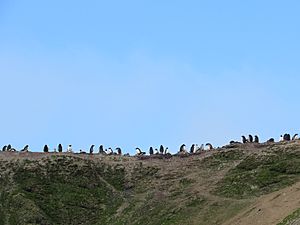Ardley Island facts for kids
|
Location in Antarctic Peninsula
|
|||||||||||||||||||||
| Geography | |||||||||||||||||||||
|---|---|---|---|---|---|---|---|---|---|---|---|---|---|---|---|---|---|---|---|---|---|
| Location | Antarctica | ||||||||||||||||||||
| Coordinates | 62°13′S 58°56′W / 62.217°S 58.933°W | ||||||||||||||||||||
| Administration | |||||||||||||||||||||
| Administered under the Antarctic Treaty System | |||||||||||||||||||||
| Demographics | |||||||||||||||||||||
| Population | Data not available | ||||||||||||||||||||
|
|||||||||||||||||||||
Ardley Island is a small island about 1 kilometer (0.6 miles) long. It is found in Maxwell Bay, very close to the southwest end of King George Island. Both islands are part of the South Shetland Islands in Antarctica.
Explorers from the Discovery II ship first mapped Ardley Island in 1935. They named it after Lieutenant R.A.B. Ardley, an officer on their ship. At first, they thought it was a peninsula (land connected to a larger landmass). But later, aerial photos showed it was actually an island. Braillard Point is the headland at its northeast end. Ardley Island is a special place for wildlife. It has been named an Antarctic Specially Protected Area (ASPA 150). This is because it has very important seabird colonies.
Contents
Amazing Birds of Ardley Island
Ardley Island is known as an Important Bird Area by BirdLife International. This means it's a key place for birds to live and breed. The island is home to a large breeding group of about 4,600 pairs of gentoo penguins. You can also find smaller numbers of Adélie and chinstrap penguins here.
Other birds that live on Ardley Island include southern giant petrels, Wilson's and black-bellied storm petrels, and Cape petrels. You might also spot brown and south polar skuas, and Antarctic terns.
In 2016, scientists studied the mud from lakes on the island. They looked at penguin droppings (called guano) in the mud. This helped them understand how penguin populations changed over 7,000 years. They found that three times, the penguin numbers grew, but then suddenly crashed. These crashes happened because of volcanic eruptions from Deception Island. This active volcano is about 120 kilometers (75 miles) southwest of Ardley Island.
Research Stations on the Island
Scientists come to Ardley Island to study its unique environment and wildlife. There are a few research shelters on the island.
Ballvé Refuge
The Ballvé Refuge consists of two buildings from Argentina. They were set up in 1953. These buildings are about 50 meters (164 feet) east of another shelter called Ripamonti I. An Argentine radio beacon nearby helps ships navigate in Maxwell Bay. All the buildings at Ballvé Refuge stay on the island all year round. Scientists often come from King George Island for their research trips. [1]
Ripamonti I Shelter
Chile has two research shelters on Ardley Island that are used mainly in the summer. Ripamonti I was built in 1982. It is located at 62°12’ S latitude and 58°53’ W longitude.
Ripamonti II Shelter
The other Chilean shelter is Ripamonti II. It used to be a hut belonging to Germany's Alfred Wegener Institute. Germany gave it to Chile in 1997. Ripamonti II is on the northern coast of Ardley Island. It is about 100 meters (328 feet) southwest from Braillard Point. This shelter is located right inside the penguin breeding areas.
See also
 In Spanish: Isla Ardley para niños
In Spanish: Isla Ardley para niños



